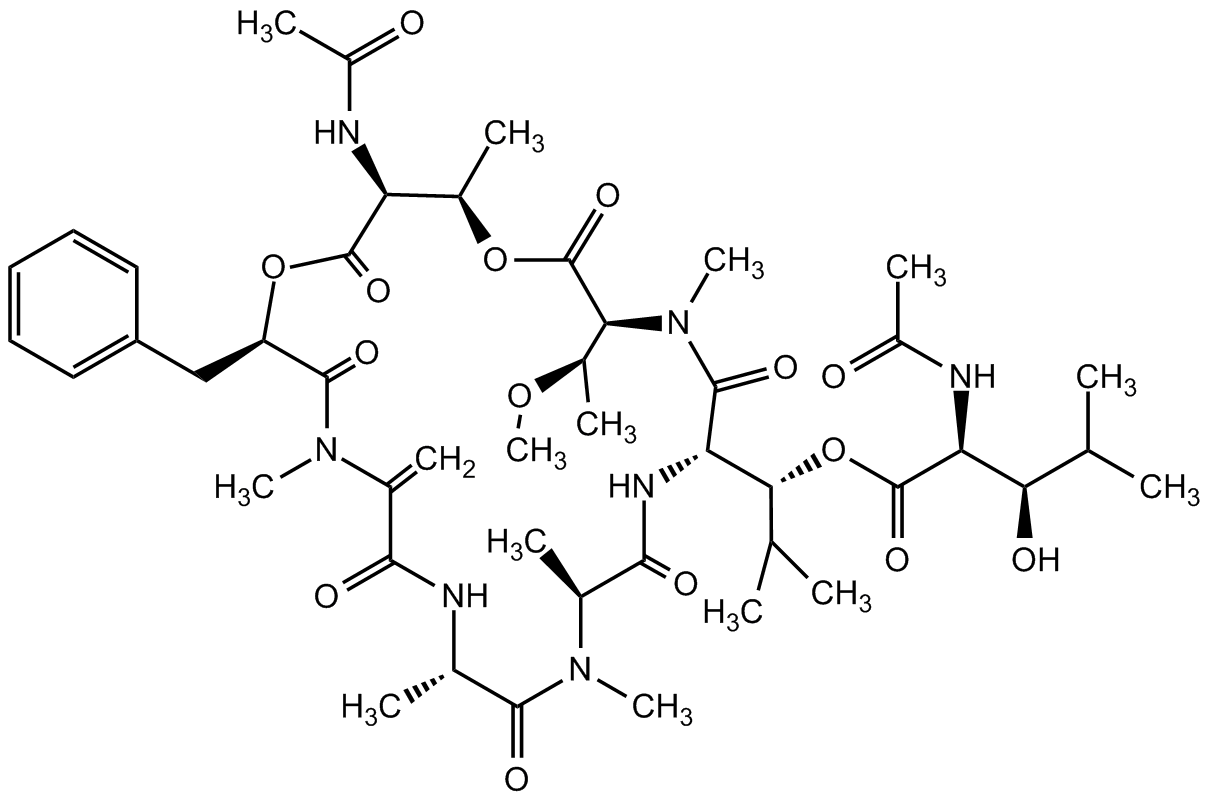
Chemical Structure
YM-254890 [568580-02-9]

AG-CN2-0509
Overview
- SupplierAdipoGen Life Sciences
- Product NameYM-254890 [568580-02-9]
- Delivery Days Customer10
- CAS Number568580-02-9
- CertificationResearch Use Only
- Estimated Purity>95%
- Molecular FormulaC46H69N7O15
- Molecular Weight960.1
- Scientific DescriptionChemical. CAS: 568580-02-9. Formula: C46H69N7O15. MW: 960.1. Cyclic depsipeptide composed of unique amino acids differing from normal amino acids. Membrane permeable, potent and selective Galphaq family inhibitor. Inhibits the signal transduction of Galphaq, Galpha11 and Galpha14 (IC50=0.095microM) by blocking the exchange of GDP for GTP, preventing the activation of the G protein. Inhibits platelet aggregation induced by ADP. Shown to inhibit Galphaq-coupled GPCR signaling by inhibiting calcium mobilization and to have antithrombotic and thrombolytic effects. Might be used as a starting point for new approaches in cancer drug discovery. Galphaq signaling has been shown to regulate brown/beige adipocytes using the structurally similar specific Galphaq family inhibitor FR900359. It is suggested that inhibition of this pathway may be a novel therapeutic approach to combat obesity. The closely related compounds YM-254890 and FR900359 (UBO-QIC) are both potent and selective Galphaq family inhibitors and were for long time only restricted accessible. The commercial availablilty of YM-254890 might give further insights into Galphaq family singaling processes. - Cyclic depsipeptide composed of unique amino acids differing from normal amino acids. Membrane permeable, potent and selective Galphaq family inhibitor. Acts in both in vivo and in vitro systems. Inhibits the signal transduction of Galphaq, Galpha11 and Galpha14 (IC50=0.095microM) by blocking the exchange of GDP for GTP, preventing the activation of the G protein. Inhibits platelet aggregation induced by ADP. Shown to inhibit Galphaq-coupled GPCR signaling by inhibiting calcium mobilization and to have antithrombotic and thrombolytic effects. Might be used as a starting point for new approaches in cancer drug discovery. Galphaq signaling has been shown to regulate brown/beige adipocytes using the structurally similar specific Galphaq family inhibitor FR900359. It is suggested that inhibition of this pathway may be a novel therapeutic approach to combat obesity. The closely related compounds YM-254890 and FR900359 (UBO-QIC) are both potent and selective Galphaq family inhibitors and were for long time only restricted accessible. The commercial availability of YM-254890 might give further insights into Galphaq family signaling processes.
- SMILESO=C(N(C)C(C(N[C@H](C(N(C)[C@H](C(N[C@@H]([C@@H](C(C)C)OC([C@@H](NC(C)=O)[C@@H](C(C)C)O)=O)C1=O)=O)C)=O)C)=O)=C)[C@H](OC([C@@H](NC(C)=O)[C@@H](C)OC([C@@H](N1C)[C@@H](C)OC)=O)=O)CC2=CC=CC=C2
- Storage Instruction-20°C,2°C to 8°C
- UNSPSC12352200
References
- YM-254890, a novel platelet aggregation inhibitor produced by Chromobacterium sp. QS3666: M. Taniguchi, et al.; J. Antibiot. 56, 358 (2003)
- A novel Galphaq/11-selective inhibitor: J. Takasaki, et al.; J. Biol. Chem. 279, 47438 (2004)
- Pharmacological properties of YM-254890, a specific G(alpha)q/11 inhibitor, on thrombosis and neointima formation in mice: T. Kawasaki, et al.; Thromb. Haemost. 94, 184 (2005)
- Effect of YM-254890, a specific G(alpha)q/11 inhibitor, on experimental peripheral arterial disease in rats: T. Uemura, et al.; Eur. J. Pharmacol. 536, 154 (2006)
- Structural basis for the specific inhibition of heterotrimeric Gq protein by a small molecule: A. Nishimura, et al.; PNAS 107, 13666 (2010)
- Total synthesis and structure-activity relationship studies of a series of selective G protein inhibitors: X.F. Xiong, et al.; Nat. Chem. 8, 1035 (2016)
- Structure, Function, Pharmacology, and Therapeutic Potential of the G Protein, Galpha/q,11: D. Kamato, et al.; Front. Cardiovasc. Med. 2, 14 (2015) (Review)
- Total synthesis of the cyclic depsipeptide YM-280193, a platelet aggregation inhibitor: H. Kaur, et al.; Org. Lett. 17, 492 (2015)
- Gaq proteins: molecular pharmacology and therapeutic potential: D. Kamato, et al.; Cell. Mol. Life Sci. (Epub ahead of print) (2016) (Review)
- The Gq signalling pathway inhibits brown and beige adipose tissue: K. Klepac, et al.; Nat. Commun. 7, 10895 (2016)
